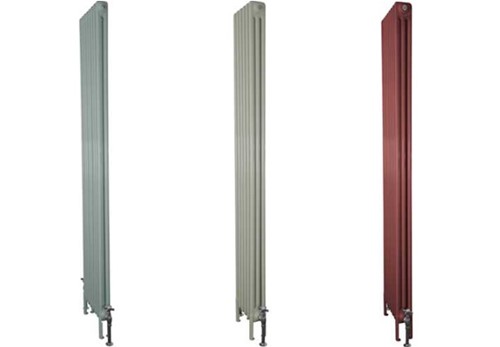Posted: Wednesday, December 16, 2020

New radiators can be a great way of improving your home’s heating efficiency or adding a fresh look to your decor - but you can have both.
To achieve this combination, you could buy any one of our cast-iron or Victorian radiators. But if you don’t want to go down that route and want something a little more contemporary, a vertical column radiator is what you’re looking for. But what are they?
Well, Trads is here to help by explaining everything there is about vertical radiators, including where best to fit them and what makes them so popular. Read on to find out more…
Vertical radiators are, as the name suggests, vertically-hung radiators that are an excellent choice if you have limited wall space available. They are a type of column radiator that’s built to an extremely high-standard using low-carbon steel for added durability and strength.
Not only does their height help to emit more heat more quickly, but they make a real statement, no matter where you put them. You could, and perhaps should, consider them a design piece all on their own because the eye is drawn to them so easily.
Vertical radiators are available in a range of colours and styles which fit into limited wall spaces and make a creative alternative to more traditional long designs. In a smaller room, these take up less space, leaving room for more fixtures and furnishings.
Vertical column radiators can be a piece of statement decor, especially if you choose a bold design to break up the traditional texture of the wall. At Trads, our steel column radiators are available in a range of colours, including shades of red, blue, green, yellow, and much more. Chances are, if you can think of it, you have a radiator painted in it.
If you’re looking to add or to retain period charm in your home but not fully vintage, a column radiator with a traditional feel is well worth considering.
Similar in style to our cast-iron radiators, these more modern models keep the “column look” but can provide more heat efficiency than their predecessors. Column radiators are functional and efficient, suitable for tank-fed and combination boilers.
Available in stunning styles, our steel column radiators can be finished in crisp white, dark anthracite and even red or blue so you can match your decor with ease. Plus, the low-carbon steel ensures they are durable and long-lasting.
Vertical radiators can be placed in most rooms, but you want to position them in a place where they will be seen, they are a design piece after all. We’ve picked out the main locations for a vertical column radiator in your home.
Vertical radiators are ideal for bathrooms because they often have limited wall space. Not only will they only take the vertical space offered in the room, but they’ll look good at the same time. Due to their vertical reach, they will provide efficient heating for the entire room space, taking less time to heat the room.
Like a bathroom, the kitchen is a great location for a vertical radiator because wall space is often at a premium. However, unlike a bathroom, your kitchen can be a place people gather for a chat or drink. This makes a vertical radiator perfect as it won’t take up much space and will provide an eye-catching statement piece in the room.
The living room, like your kitchen, is somewhere that you’ll entertain people. So you could make a statement with bold colours and designs. You can combine vertical radiators with other column radiators to provide excellent heat while making a bold design statement for your decor. Their reach will also help warm a larger more quickly.
Choosing the correct BTU rating for a radiator will help to create a comfortable environment and reduce energy waste, such as saving money on your bills and the cost of a large radiator when a smaller one will do.
The general rule is, that the larger the radiator the higher the BTU rating will be. It should be noted that this usually only applies to each individual radiator. Therefore, the best radiators for heat output are large radiators. So, vertical radiators will have a higher BTU rating with a high heat output, ideal for whichever room you fit them.
Vertical radiators can also be useful in living rooms where a couch or your furniture would block a standard horizontal radiator. With a vertical radiator, you could achieve greater BTU outputs because of the heat not being absorbed by chairs, sofas and other objects.
Installation is easy and direct, like all radiators, allowing you to plumb them straight into your central heating system. This ensures you are provided with something that’s powerful, efficient and looks amazing.
Is it time you updated your radiators? Here at Trads, we have an excellent range of beautiful cast iron and steel radiators to update your home with!
Feel free to contact us if you need any help choosing a radiator